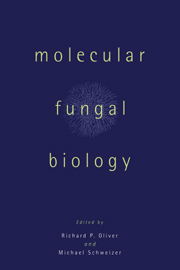Book contents
- Frontmatter
- Contents
- List of contributors
- Preface
- 1 Fungi: important organisms in history and today
- 2 Fungal phylogeny
- 3 The yeast Saccharomyces cerevisiae: insights from the first complete eukaryotic genome sequence
- 4 Interactions between pathway-specific and global genetic regulation and the control of pathway flux
- 5 Hyphal cell biology
- 6 Asexual sporulation: conidiation
- 7 Fungal cell division
- 8 Sexual development of higher fungi
- 9 Lignocellulose breakdown and utilization by fungi
- 10 Plant disease caused by fungi: phytopathogenicity
- 11 Fungi as animal pathogens
- 12 Biotechnology of filamentous fungi: applications of molecular biology
- Index
8 - Sexual development of higher fungi
Published online by Cambridge University Press: 05 June 2012
- Frontmatter
- Contents
- List of contributors
- Preface
- 1 Fungi: important organisms in history and today
- 2 Fungal phylogeny
- 3 The yeast Saccharomyces cerevisiae: insights from the first complete eukaryotic genome sequence
- 4 Interactions between pathway-specific and global genetic regulation and the control of pathway flux
- 5 Hyphal cell biology
- 6 Asexual sporulation: conidiation
- 7 Fungal cell division
- 8 Sexual development of higher fungi
- 9 Lignocellulose breakdown and utilization by fungi
- 10 Plant disease caused by fungi: phytopathogenicity
- 11 Fungi as animal pathogens
- 12 Biotechnology of filamentous fungi: applications of molecular biology
- Index
Summary
Introduction
Fungal mycelia will continue to grow and invade new substrates for as long as satisfactory conditions prevail (Chapter 9), typically producing numerous asexual spores (Chapter 7) and other mitotically derived invasive, reproductive and/or resistant structures (strands, rhizomorphs, sclerotia, stromata, etc.). Except for the Mycelia Sterilia (Deuteromycotina, Chapter 2), under particular conditions a fungus enters a sexual pathway, resulting in genetic segregation and production of recombinant progeny.
Since most fungi seem to be haploid for most of their life cycles, the first step in this process is to bring together two haploids so that nuclei can coexist in the same cytoplasm, undergo karyogamy followed by the meiotic division, and then generate and distribute progeny spores. These processes are considered in this chapter (see also Carlile and Watkinson, 1994; Elliott, 1994; Moore, 1998).
Sex: what and why?
Most fungi produce abundant asexual spores which are extremely effective in dispersing the organism. We have to ask why so many fungi invest more resources in a more complex sexual reproduction. There are, indeed, many fungi which only reproduce asexually but the majority still have a sexual cycle. Sex must have selective advantage if sexual stages are not to be replaced by asexual ones entirely (Maynard Smith, 1978).
The crucial point which provides the contrast with asexual reproduction is fusion of nuclei derived from different individuals. If the individuals differ in genotype, the fusion nucleus will be heterozygous and the products of the meiotic division can have recombinant genotypes.
- Type
- Chapter
- Information
- Molecular Fungal Biology , pp. 231 - 271Publisher: Cambridge University PressPrint publication year: 1999
- 1
- Cited by

